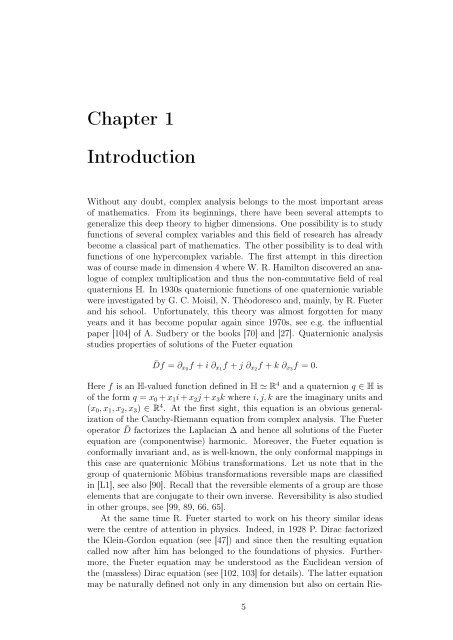Hypercomplex Analysis Selected Topics
Hypercomplex Analysis Selected Topics
Hypercomplex Analysis Selected Topics
You also want an ePaper? Increase the reach of your titles
YUMPU automatically turns print PDFs into web optimized ePapers that Google loves.
Chapter 1<br />
Introduction<br />
Without any doubt, complex analysis belongs to the most important areas<br />
of mathematics. From its beginnings, there have been several attempts to<br />
generalize this deep theory to higher dimensions. One possibility is to study<br />
functions of several complex variables and this field of research has already<br />
become a classical part of mathematics. The other possibility is to deal with<br />
functions of one hypercomplex variable. The first attempt in this direction<br />
was of course made in dimension 4 where W. R. Hamilton discovered an analogue<br />
of complex multiplication and thus the non-commutative field of real<br />
quaternions H. In 1930s quaternionic functions of one quaternionic variable<br />
were investigated by G. C. Moisil, N. Théodoresco and, mainly, by R. Fueter<br />
and his school. Unfortunately, this theory was almost forgotten for many<br />
years and it has become popular again since 1970s, see e.g. the influential<br />
paper [104] of A. Sudbery or the books [70] and [27]. Quaternionic analysis<br />
studies properties of solutions of the Fueter equation<br />
¯Df = ∂x0f + i ∂x1f + j ∂x2f + k ∂x3f = 0.<br />
Here f is an H-valued function defined in H R 4 and a quaternion q ∈ H is<br />
of the form q = x0 + x1i + x2j + x3k where i, j, k are the imaginary units and<br />
(x0, x1, x2, x3) ∈ R 4 . At the first sight, this equation is an obvious generalization<br />
of the Cauchy-Riemann equation from complex analysis. The Fueter<br />
operator ¯ D factorizes the Laplacian ∆ and hence all solutions of the Fueter<br />
equation are (componentwise) harmonic. Moreover, the Fueter equation is<br />
conformally invariant and, as is well-known, the only conformal mappings in<br />
this case are quaternionic Möbius transformations. Let us note that in the<br />
group of quaternionic Möbius transformations reversible maps are classified<br />
in [L1], see also [90]. Recall that the reversible elements of a group are those<br />
elements that are conjugate to their own inverse. Reversibility is also studied<br />
in other groups, see [99, 89, 66, 65].<br />
At the same time R. Fueter started to work on his theory similar ideas<br />
were the centre of attention in physics. Indeed, in 1928 P. Dirac factorized<br />
the Klein-Gordon equation (see [47]) and since then the resulting equation<br />
called now after him has belonged to the foundations of physics. Furthermore,<br />
the Fueter equation may be understood as the Euclidean version of<br />
the (massless) Dirac equation (see [102, 103] for details). The latter equation<br />
may be naturally defined not only in any dimension but also on certain Rie-<br />
5

















